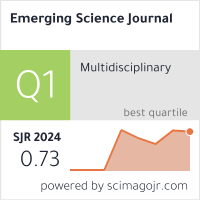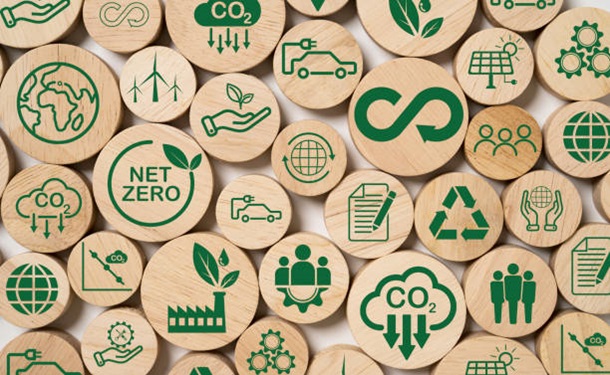Gender Differences in Academic Staff Performance: An Advanced Analysis Using PLS-SEM in Higher Education
Downloads
Doi:10.28991/ESJ-2024-SIED1-09
Full Text:PDF
Downloads
Taufiq Hail, G. A.-M. (2020). Educational Learning and Teaching Methods' Challenges during COVID-19 Outbreak and a Sudden Transformation Towards Totally Digitizing Education. International Journal of Education and Science, 3(2), 56-57. doi:10.26697/ijes.2020.2.39.
Mukhopadhyay, U. (2023). Impact of COVID-19 pandemic on academic performance and work–life balance of women academicians. Asian Journal of Social Science, 51(1), 62–70. doi:10.1016/j.ajss.2022.07.003.
Aljahromi, D. (2020). Towards the provision of effective interaction in post Covid-19 e-learning contexts: Enhancing e-interactions on the LMS's discussion boards. Proceedings of the International Conference on e-Learning, ICEL, Vols. 2020-December, 98–103. IEEE, Sakheer. doi:10.1109/econf51404.2020.9385502.
Taufiq-Hail, G. A. M., Aljahromi, Di., Sarea, A., & Kostikova, I. (2021). Academic Staff Perceptions on Students' Traditional Assessment Transformations towards Online Evaluation during COVID-19 Pandemic in Higher Education: A Preliminary Study from Two Diverse Cultures. In 2021 Sustainable Leadership and Academic Excellence International Conference, SLAE 2021, 16–25. doi:10.1109/SLAE54202.2021.9686904.
Saw, G. K., Chang, C. N., & Lin, S. (2023). Gender disparities in remote teaching readiness and mental health problems among university faculty during the COVID-19 pandemic. Educational and Developmental Psychologist, 40(1), 131–140. doi:10.1080/20590776.2022.2108697.
Bloshchynskyi, I., Bahrii, H., Nanivska, L., Tsviak, L., Isaieva, I., Skyba, K., Pilishek, S., Moroz, N., Herasimova, O., Yamkova, V., & Mishchynska, I. (2022). Gender Characteristics of Individual's Linguistic Behavior in the Context of Future Translators' Professional Training. Emerging Science Journal, 6(Special Issue), 199–208. doi:10.28991/ESJ-2022-SIED-014.
Rokach, A. (2018). The effect of gender and culture on loneliness: A mini review. Emerging Science Journal, 2(2), 59–64. doi:10.28991/esj-2018-01128.
Lobos, K., Cobo-Rendón, R., Sáez, F., Mella, J., & Cisternas, N. (2023). Return to Face-to-Face Classrooms in Higher Education: Students Experiences in Chile, Venezuela, and Ecuador. Emerging Science Journal, 7(Special Issue 2), 217–237. doi:10.28991/ESJ-2023-SIED2-017.
Corbett, L., Bauman, A., Peralta, L. R., Okely, A. D., & Phongsavan, P. (2024). Lifestyle and work-related correlates of psychosocial health among Australian teachers: a cross-sectional study. Journal of Public Health (Germany), 32(6), 999–1009. doi:10.1007/s10389-023-01874-9.
García-Fernández, L., Romero-Ferreiro, V., Padilla, S., David López-Roldán, P., Monzó-García, M., & Rodriguez-Jimenez, R. (2021). Gender differences in emotional response to the COVID-19 outbreak in Spain. Brain and Behavior, 11(1), 1934. doi:10.1002/brb3.1934.
Hamid, A. A. M., & Abdullah, A. S. (2020). Job distress and burnout among Tanzanian and Sudanese health professionals: a comparative study. South African Journal of Psychology, 50(3), 411–424. doi:10.1177/0081246319898054.
Karaboga, T., Erdal, N., Karaboga, H. A., & Tatoglu, E. (2023). Creativity as a mediator between personal accomplishment and task performance: A multigroup analysis based on gender during the COVID-19 pandemic. Current Psychology, 42(15), 12517–12529. doi:10.1007/s12144-021-02510-z.
Qian, Y., & Fan, W. (2024). Stressful life events and depressive symptoms during COVID-19: A gender comparison. British Journal of Sociology, 75(1), 38–47. doi:10.1111/1468-4446.13067.
André, S., & van der Zwan, R. (2023). The influence of the COVID-19 pandemic on changes in perceived work pressure for Dutch mothers and fathers. Gender, Work and Organization, 30(3), 1015–1034. doi:10.1111/gwao.12951.
Hess, U., Senecal, S., Kirouac, G., Herrera, P., Philippot, P., & Kleck, R. E. (2000). Emotional expressivity in men and women: Stereotypes and self-perceptions. Cognition and Emotion, 14(5), 609–642. doi:10.1080/02699930050117648.
Ross, C. E., & Willigen, M. Van. (1996). Gender, Parenthood, and Anger. Journal of Marriage and the Family, 58(3), 572. doi:10.2307/353718.
Simon, R. W., & Nath, L. E. (2004). Gender and emotion in the United States: Do men and women differ in self-reports of feelings and expressive behavior? American Journal of Sociology, 109(5), 1137–1176. doi:10.1086/382111.
Ali, N., Nitschke, J. P., Cooperman, C., Baldwin, M. W., & Pruessner, J. C. (2020). Systematic manipulations of the biological stress systems result in sex-specific compensatory stress responses and negative mood outcomes. Neuropsychopharmacology, 45(10), 1672–1680. doi:10.1038/s41386-020-0726-8.
Bangasser, D. A., & Wicks, B. (2017). Sex-specific mechanisms for responding to stress. Journal of Neuroscience Research, 95(1–2), 75–82. doi:10.1002/jnr.23812.
Pruessner, J. C. (2018). The interplay of sex and gender on the reactivity of the endocrine stress axis in humans. Current Opinion in Behavioral Sciences, 23, 191–195. doi:10.1016/j.cobeha.2018.08.003.
Taylor, C. L., Ivcevic, Z., Moeller, J., Menges, J. I., Reiter-Palmon, R., & Brackett, M. A. (2022). Gender and Emotions at Work: Organizational Rank Has Greater Emotional Benefits for Men than Women. Sex Roles, 86(1–2), 127–142. doi:10.1007/s11199-021-01256-z.
Abbruzzese, L., Magnani, N., Robertson, I. H., & Mancuso, M. (2019). Age and gender differences in emotion recognition. Frontiers in Psychology, 10(Octber), 1-15. doi:10.3389/fpsyg.2019.02371.
Deng, Y., Chang, L., Yang, M., Huo, M., & Zhou, R. (2016). Gender differences in emotional response: Inconsistency between experience and expressivity. PLoS ONE, 11(6), 158666. doi:10.1371/journal.pone.0158666.
Lausen, A., & Schacht, A. (2018). Gender differences in the recognition of vocal emotions. Frontiers in Psychology, 9(June), 1-22. doi:10.3389/fpsyg.2018.00882.
Storek, J., & Furnham, A. (2014). Gender and task confidence as predictors of the Domain-Masculine Intelligence Type (DMIQ). Personality and Individual Differences, 69, 43–49. doi:10.1016/j.paid.2014.05.006.
Deole, S. S., Deter, M., & Huang, Y. (2023). Home sweet home: Working from home and employee performance during the COVID-19 pandemic in the UK. Labour Economics, 80, 102295. doi:10.1016/j.labeco.2022.102295.
Stengård, J., Mellner, C., Toivanen, S., & Nyberg, A. (2022). Gender Differences in the Work and Home Spheres for Teachers, and Longitudinal Associations with Depressive Symptoms in a Swedish Cohort. Sex Roles, 86(3–4), 159–178. doi:10.1007/s11199-021-01261-2.
Wang, Y., Xia, M., Guo, W., Xu, F., & Zhao, Y. (2023). Academic performance under COVID-19: The role of online learning readiness and emotional competence. Current Psychology, 42(34), 30562–30575. doi:10.1007/s12144-022-02699-7.
Hamadeh, R. R., AlSabbagh, M., Bugawa, A. M., Kamal, A., Ali, F., Al Bufalasa, G. A., & AlShaibani, T. (2022). The impact of the COVID-19 pandemic in higher education: a gender perspective. Arab Gulf Journal of Scientific Research, 40(4), 424–439. doi:10.1108/AGJSR-07-2022-0104.
Taufiq-Hail, G. A. M., Sarea, A., & Hawaldar, I. T. (2021). The impact of self-efficacy on feelings and task performance of academic and teaching staff in bahrain during covid-19: Analysis by sem and ann. Journal of Open Innovation: Technology, Market, and Complexity, 7(4), 224. doi:10.3390/joitmc7040224.
Zia, A. (2020). Exploring factors influencing online classes due to social distancing in COVID-19 pandemic: a business students perspective. International Journal of Information and Learning Technology, 37(4), 197–211. doi:10.1108/IJILT-05-2020-0089.
Tsui, A. B. M., Chan, C. K. K., Harfitt, G., & Leung, P. (2020). Crisis and opportunity in teacher preparation in the pandemic: exploring the "adjacent possible.” Journal of Professional Capital and Community, 5(3–4), 237–245. doi:10.1108/JPCC-07-2020-0061.
Lopes de Sousa Jabbour, A. B., Chiappetta Jabbour, C. J., Hingley, M., Vilalta-Perdomo, E. L., Ramsden, G., & Twigg, D. (2020). Sustainability of supply chains in the wake of the coronavirus (COVID-19/SARS-CoV-2) pandemic: lessons and trends. Modern Supply Chain Research and Applications, 2(3), 117–122. doi:10.1108/mscra-05-2020-0011.
López López, L. (Licho), McCaw, C. T., Di Biase, R., McKernan, A., Rudolph, S., Galatis, A., Dulfer, N., Gerrard, J., McKinley, E., McLeod, J., & Rizvi, F. (2020). The quarantine archives: educators in "social isolation.” History of Education Review, 49(2), 195–213. doi:10.1108/HER-05-2020-0028.
Alawamleh, M., Al-Twait, L. M., & Al-Saht, G. R. (2022). The effect of online learning on communication between instructors and students during Covid-19 pandemic. Asian Education and Development Studies, 11(2), 380–400. doi:10.1108/AEDS-06-2020-0131.
Hampel, R., & Stickler, U. (2005). New skills for new classrooms: Training tutors to teach languages online. Computer Assisted Language Learning, 18(4), 311–326. doi:10.1080/09588220500335455.
Easton, S. S. (2003). Clarifying the instructor's role in online distance learning. Communication Education, 52(2), 87–105. doi:10.1080/03634520302470.
Biddle, B. (1986). Recent Developments in Role Theory. Annual Review of Sociology, 12(1), 67–92. doi:10.1146/annurev.soc.12.1.67.
Zhang, Y. G., Dang, M. Y., & Chen, H. (2020). An Explorative Study on the Virtual World: Investigating the Avatar Gender and Avatar Age Differences in their Social Interactions for Help-Seeking. Information Systems Frontiers, 22(4), 911–925. doi:10.1007/s10796-019-09904-2.
Plant, E. A., Hyde, J. S., Keltner, D., & Devine, P. G. (2000). The gender stereotyping of emotions. Psychology of Women Quarterly, 24(1), 81–92. doi:10.1111/j.1471-6402.2000.tb01024.x.
Shields, S. A. (2013). Gender and Emotion: What We Think We Know, What We Need to Know, and Why It Matters. Psychology of Women Quarterly, 37(4), 423–435. doi:10.1177/0361684313502312.
Wood, W., & Eagly, A. H. (2002). A cross-cultural analysis of the behavior of women and men: Implications for the origins of sex differences. Psychological Bulletin, 128(5), 699–727. doi:10.1037/0033-2909.128.5.699.
Grossman, M., & Wood, W. (1993). Sex Differences in Intensity of Emotional Experience: A Social Role Interpretation. Journal of Personality and Social Psychology, 65(5), 1010–1022. doi:10.1037/0022-3514.65.5.1010.
PLUTCHIK, R. (1980). a General Psychoevolutionary Theory of Emotion. In Theories of Emotion. Theor. Emot., Elsevier. doi:10.1016/b978-0-12-558701-3.50007-7.
Brody, L. R. (1985). Gender differences in emotional development: A review of theories and research. Journal of Personality, 53(2), 102–149. doi:10.1111/j.1467-6494.1985.tb00361.x.
Venkatesh, V., Morris, M. G., Davis, G. B., & Davis, F. D. (2003). User acceptance of information technology: Toward a unified view. MIS Quarterly: Management Information Systems, 27(3), 425–478. doi:10.2307/30036540.
Venkatesh, V., Thong, J. Y. L., & Xu, X. (2012). Consumer acceptance and use of information technology: Extending the unified theory of acceptance and use of technology. MIS Quarterly: Management Information Systems, 36(1), 157–178. doi:10.2307/41410412.
Yuan, S., Liu, Y., Yao, R., & Liu, J. (2016). An investigation of users' continuance intention towards mobile banking in China. Information Development, 32(1), 20–34. doi:10.1177/0266666914522140.
Hew, J. J., Lee, V. H., Ooi, K. B., & Wei, J. (2015). What catalyses mobile apps usage intention: An empirical analysis. Industrial Management and Data Systems, 115(7), 1269–1291. doi:10.1108/IMDS-01-2015-0028.
Wong, C. H., Tan, G. W. H., Loke, S. P., & Ooi, K. B. (2014). Mobile TV: A new form of entertainment? Industrial Management and Data Systems, 114(7), 1050–1067. doi:10.1108/IMDS-05-2014-0146.
Ohlott, P. J., Ruderman, M. N., & McCauley, C. D. (1994). Gender Differences in Managers' Developmental Job Experiences. Academy of Management Journal, 37(1), 46–67. doi:10.2307/256769.
Woodall, J., Edwards, C., & Welchman, R. (1997). Organizational restructuring and the achievement of an equal opportunity culture. Gender, Work and Organization, 4(1), 2–12. doi:10.1111/1468-0432.t01-1-00019.
Singh, S., Bhutani, S., & Fatima, H. (2020). Surviving the stigma: lessons learnt for the prevention of COVID-19 stigma and its mental health impact. Mental Health and Social Inclusion, 24(3), 145–149. doi:10.1108/MHSI-05-2020-0030.
Kelly, M. M., Tyrka, A. R., Anderson, G. M., Price, L. H., & Carpenter, L. L. (2008). Sex differences in emotional and physiological responses to the Trier Social Stress Test. Journal of Behavior Therapy and Experimental Psychiatry, 39(1), 87–98. doi:10.1016/j.jbtep.2007.02.003.
Goldfarb, E. V., Seo, D., & Sinha, R. (2019). Sex differences in neural stress responses and correlation with subjective stress and stress regulation. Neurobiology of Stress, 11, 100177. doi:10.1016/j.ynstr.2019.100177.
Bilodeau, J., Marchand, A., & Demers, A. (2020). Psychological distress inequality between employed men and women: A gendered exposure model. SSM - Population Health, 11, 100626. doi:10.1016/j.ssmph.2020.100626.
Calvarese, M. (2015). The effect of gender on stress factors: An exploratory study among university students. Social Sciences, 4(4), 1177–1184. doi:10.3390/socsci4041177.
Bodenmann, G., Meuwly, N., Germann, J., Nussbeck, F. W., Heinrichs, M., & Bradbury, T. N. (2015). Effects of Stress on the Social Support Provided by Men and Women in Intimate Relationships. Psychological Science, 26(10), 1584–1594. doi:10.1177/0956797615594616.
Youssef, F. F., Bachew, R., Bissessar, S., Crockett, M. J., & Faber, N. S. (2018). Sex differences in the effects of acute stress on behavior in the ultimatum game. Psychoneuroendocrinology, 96, 126–131. doi:10.1016/j.psyneuen.2018.06.012.
Rossi, R., Socci, V., Talevi, D., Mensi, S., Niolu, C., Pacitti, F., Di Marco, A., Rossi, A., Siracusano, A., & Di Lorenzo, G. (2020). COVID-19 Pandemic and Lockdown Measures Impact on Mental Health Among the General Population in Italy. Frontiers in Psychiatry, 11. doi:10.3389/fpsyt.2020.00790.
Sobregrau Sangrí , P., Aguiló Mir, S., Castro Ribeiro, T., Esteban-Sepúlveda, S., García Pagès, E., López Barbeito, B., Pomar Moya-Prats, J. L., Pintor Pérez, L., & Aguiló Llobet, J. (2022). Mental health assessment of Spanish healthcare workers during the SARS-CoV-2 pandemic. A cross-sectional study. Comprehensive Psychiatry, 112, 152278. doi:10.1016/j.comppsych.2021.152278.
Stella, M., Restocchi, V., & Deyne, S. De. (2020). #Lockdown: Network-enhanced emotional profiling in the time of covid-19. Big Data and Cognitive Computing, 4(2), 1–23. doi:10.3390/bdcc4020014.
Wang, C., Pan, R., Wan, X., Tan, Y., Xu, L., Ho, C. S., & Ho, R. C. (2020). Immediate psychological responses and associated factors during the initial stage of the 2019 coronavirus disease (COVID-19) epidemic among the general population in China. International Journal of Environmental Research and Public Health, 17(5)m 1729. doi:10.3390/ijerph17051729.
Shahrour, G., & Dardas, L. A. (2020). Acute stress disorder, coping self-efficacy and subsequent psychological distress among nurses amid COVID-19. Journal of Nursing Management, 28(7), 1686–1695. doi:10.1111/jonm.13124.
Liu, N., Zhang, F., Wei, C., Jia, Y., Shang, Z., Sun, L., Wu, L., Sun, Z., Zhou, Y., Wang, Y., & Liu, W. (2020). Prevalence and predictors of PTSS during COVID-19 outbreak in China hardest-hit areas: Gender differences matter. Psychiatry Research, 287, 112921. doi:10.1016/j.psychres.2020.112921.
Olaseni, A. O., Akinsola, O. S., Agberotimi, S. F., & Oguntayo, R. (2020). Psychological distress experiences of Nigerians during Covid-19 pandemic; the gender difference. Social Sciences and Humanities Open, 2(1), 100052. doi:10.1016/j.ssaho.2020.100052.
van der Vegt, I., & Kleinberg, B. (2020). Women Worry About Family, Men About the Economy: Gender Differences in Emotional Responses to COVID-19. In S. Aref, K. Bontcheva, M. Braghieri, F. Dignum, F. Giannotti, F. Grisolia, & D. Pedreschi (Eds.), Lecture Notes in Computer Science (including subseries Lecture Notes in Artificial Intelligence and Lecture Notes in Bioinformatics): Vol. 12467 LNCS, 397–409. doi:10.1007/978-3-030-60975-7_29.
Prowse, R., Sherratt, F., Abizaid, A., Gabrys, R. L., Hellemans, K. G. C., Patterson, Z. R., & McQuaid, R. J. (2021). Coping With the COVID-19 Pandemic: Examining Gender Differences in Stress and Mental Health Among University Students. Frontiers in Psychiatry, 12. doi:10.3389/fpsyt.2021.650759.
Elliott, M., & Blithe, S. J. (2020). Gender Inequality, Stress Exposure, and Well-Being among Academic Faculty. International Journal of Higher Education, 10(2), 240. doi:10.5430/ijhe.v10n2p240.
García-González, M. A., Torrano, F., & García-González, G. (2020). Analysis of stress factors for female professors at online universities. International Journal of Environmental Research and Public Health, 17(8), 2958. doi:10.3390/ijerph17082958.
Bandura, A. (1986). The Explanatory and Predictive Scope of Self-Efficacy Theory. Journal of Social and Clinical Psychology, 4(3), 359–373. doi:10.1521/jscp.1986.4.3.359.
Taufiq-Hail, G. A. M., & Sarea, A. (2021). An Empirical Evaluation of the Credibility, Trust Perceptions, and Compatibility with Cloud-Based Services: The Case of Higher Education in Malaysia. In A.-E. Hassanien, K.-C. Chang, T. Mincong, & A. M. Learn (Eds.), Advances in Intelligent Systems and Computing, 1339, 753–773. doi:10.1007/978-3-030-69717-4_70.
Arslan, M., & Roudaki, J. (2019). Examining the role of employee engagement in the relationship between organisational cynicism and employee performance. International Journal of Sociology and Social Policy, 39(1–2), 118–137. doi:10.1108/IJSSP-06-2018-0087.
Sonnentag, S., & Frese, M. (2002). Performance Concepts and Performance Theory. In S. Sonnentag (Ed.), Psychological Management of Individual Performance, 1–25. doi:10.1002/0470013419.ch1.
Cronin, B. (1982). Performance Measurement and Information Management. Aslib Proceedings, 34(5), 227–236. doi:10.1108/eb050844.
Koopmans, L., Bernaards, C. M., Hildebrandt, V. H., De Vet, H. C. W., & Van Der Beek, A. J. (2014). Construct validity of the individual work performance questionnaire. Journal of Occupational and Environmental Medicine, 56(3), 331–337. doi:10.1097/JOM.0000000000000113.
Saleem, M. A., Bhutta, Z. M., Nauman, M., & Zahra, S. (2019). Enhancing performance and commitment through leadership and empowerment: An emerging economy perspective. International Journal of Bank Marketing, 37(1), 303–322. doi:10.1108/IJBM-02-2018-0037.
Nes, L. S., & Optimism. (2016). Stress: Concepts, Cognition, Emotion, and Behavior. Stress: Concepts, Cognition, Emotion, and Behavior, 405–411. doi:10.1016/c2013-0-12842-5.
Solberg Nes, L., & Segerstrom, S. C. (2006). Dispositional optimism and coping: A meta-analytic review. Personality and Social Psychology Review, 10(3), 235–251. doi:10.1207/s15327957pspr1003_3.
Arslan, G., Yıldırım, M., Tanhan, A., Buluş, M., & Allen, K. A. (2021). Coronavirus Stress, Optimism-Pessimism, Psychological Inflexibility, and Psychological Health: Psychometric Properties of the Coronavirus Stress Measure. International Journal of Mental Health and Addiction, 19(6), 2423–2439. doi:10.1007/s11469-020-00337-6.
Tanhan, A. (2019). Acceptance and commitment therapy with ecological systems theory: Addressing muslim mental health issues and wellbeing. Journal of Positive Psychology and Wellbeing, 3(2), 197–219. doi:10.47602/jpsp.v3i2.172.
Yao, Z., Zhang, X., Luo, J., & Huang, H. (2020). Offense is the best defense: the impact of workplace bullying on knowledge hiding. Journal of Knowledge Management, 24(3), 675–695. doi:10.1108/JKM-12-2019-0755.
Zhang, J., Wu, W., Zhao, X., & Zhang, W. (2020). Recommended psychological crisis intervention response to the 2019 novel coronavirus pneumonia outbreak in China: A model of West China Hospital. Precision Clinical Medicine, 3(1), 3–8. doi:10.1093/pcmedi/pbaa006.
Bao, Y., Sun, Y., Meng, S., Shi, J., & Lu, L. (2020). 2019-nCoV epidemic: address mental health care to empower society. The Lancet, 395(10224), e37–e38. doi:10.1016/S0140-6736(20)30309-3.
Bandura, A. (1977). Self-efficacy: Toward a unifying theory of behavioral change. Psychological Review, 84(2), 191–215. doi:10.1037/0033-295X.84.2.191.
Bandura, A., & Watts, R. E. (1996). Self-Efficacy in Changing Societies. Journal of Cognitive Psychotherapy, 10(4), 313. doi:10.1891/0889-8391.10.4.313.
Schunk, D. H. (1995). Self-efficacy, motivation, and performance. Journal of Applied Sport Psychology, 7(2), 112–137. doi:10.1080/10413209508406961.
Schmidt, A. M., & DeShon, R. P. (2010). The Moderating Effects of Performance Ambiguity on the Relationship Between Self-Efficacy and Performance. Journal of Applied Psychology, 95(3), 572–581. doi:10.1037/a0018289.
Hair Jr, J. F., Sarstedt, M., Ringle, C. M., & Gudergan, S. P. (2018). Advanced issues in partial least squares structural equation modeling. SAGE Publications, California, United States.
Erdfelder, E., FAul, F., Buchner, A., & Lang, A. G. (2009). Statistical power analyses using G*Power 3.1: Tests for correlation and regression analyses. Behavior Research Methods, 41(4), 1149–1160. doi:10.3758/BRM.41.4.1149.
Cohen, J. (1992). Quantitative methods in psychology. Psychological Bulletin, 112(1), 155–159.
Podsakoff, P. M., MacKenzie, S. B., Lee, J. Y., & Podsakoff, N. P. (2003). Common Method Biases in Behavioral Research: A Critical Review of the Literature and Recommended Remedies. Journal of Applied Psychology, 88(5), 879–903. doi:10.1037/0021-9010.88.5.879.
Hair, J. F., Ringle, C. M., & Sarstedt, M. (2011). PLS-SEM: Indeed a silver bullet. Journal of Marketing Theory and Practice, 19(2), 139–152. doi:10.2753/MTP1069-6679190202.
Hair, J. F., Sarstedt, M., Hopkins, L., & Kuppelwieser, V. G. (2014). Partial least squares structural equation modeling (PLS-SEM): An emerging tool in business research. European Business Review, 26(2), 106–121. doi:10.1108/EBR-10-2013-0128.
Henseler, J., Hubona, G., & Ray, P. A. (2016). Using PLS path modeling in new technology research: Updated guidelines. Industrial Management and Data Systems, 116(1), 2–20. doi:10.1108/IMDS-09-2015-0382.
Chin, W., Cheah, J. H., Liu, Y., Ting, H., Lim, X. J., & Cham, T. H. (2020). Demystifying the role of causal-predictive modeling using partial least squares structural equation modeling in information systems research. Industrial Management and Data Systems, 120(12), 2161–2209. doi:10.1108/IMDS-10-2019-0529.
Sharma, P. N., Liengaard, B. D., Hair, J. F., Sarstedt, M., & Ringle, C. M. (2023). Predictive model assessment and selection in composite-based modeling using PLS-SEM: extensions and guidelines for using CVPAT. European Journal of Marketing, 57(6), 1662–1677. doi:10.1108/EJM-08-2020-0636.
Hair, J., & Alamer, A. (2022). Partial Least Squares Structural Equation Modeling (PLS-SEM) in second language and education research: Guidelines using an applied example. Research Methods in Applied Linguistics, 1(3), 100027. doi:10.1016/j.rmal.2022.100027.
Taylor, S., & Todd, P. A. (1995). Understanding information technology usage: A test of competing models. Information Systems Research, 6(2), 144–176. doi:10.1287/isre.6.2.144.
Zolait, A. H. S. (2014). The nature and components of perceived behavioural control as an element of theory of planned behaviour. Behaviour and Information Technology, 33(1), 65–85. doi:10.1080/0144929X.2011.630419.
Ringle, C. M., Wende, S., & Becker, J. M. S. (2015). SmartPLS GmbH: Boenningstedt. Hournal od Service Science and Management, Germany.
Chin, W. W. (1998). The partial least squares approach to structural equation modeling. Modern methods for business research, 295(2), 295-336.
Ramayah, T., Soto-Acosta, P., Colomo-Palacios, R., Gopi, M., & Popa, S. (2014). Explaining the adoption of Internet stock trading in Malaysia: Comparing models. Asian Journal of Technology Innovation, 22(1), 131–151. doi:10.1080/19761597.2013.873110.
Fornell, C., & Larcker, D. F. (1981). Evaluating Structural Equation Models with Unobservable Variables and Measurement Error. Journal of Marketing Research, 18(1), 39. doi:10.2307/3151312.
Sarstedt, M., Ringle, C. M., Smith, D., Reams, R., & Hair, J. F. (2014). Partial least squares structural equation modeling (PLS-SEM): A useful tool for family business researchers. Journal of Family Business Strategy, 5(1), 105–115. doi:10.1016/j.jfbs.2014.01.002.
Zimmerman, B. J., Bandura, A., & Martinez-Pons, M. (1992). Self-Motivation for Academic Attainment: The Role of Self-Efficacy Beliefs and Personal Goal Setting. American Educational Research Journal, 29(3), 663–676. doi:10.3102/00028312029003663.
Lee, P. C., & Mao, Z. (2016). The relation among self-efficacy, learning approaches, and academic performance: An exploratory study. Journal of Teaching in Travel and Tourism, 16(3), 178–194. doi:10.1080/15313220.2015.1136581.
De Pater, I. E., Van Vianen, A. E. M., Fischer, A. H., & Van Ginkel, W. P. (2009). Challenging experiences: Gender differences in task choice. Journal of Managerial Psychology, 24(1), 4–28. doi:10.1108/02683940910922519.
Henseler, J. (2017). Partial least squares path modeling. Advanced methods for modeling markets, 361-381. doi:10.1007/978-3-319-53469-5_12
Aali, H. Al, & Aljahromi, D. (2021). An Examination of Leadership Styles of Women in Academia in the Kingdom of Bahrain. Sustainable Leadership and Academic Excellence International Conference, 1–7. doi:10.1109/SLAE54202.2021.9788071.
Henseler, J. (2007). A New and Simple Approach to Multi-group Analysis in Partial Least Squares Path Modeling. Proceedings of PLS'07: 5th International Symposium on PLS and Related Methods, 104–107.
Henseler, J., & Fassott, G. (2010). Testing Moderating Effects in PLS Path Models: An Illustration of Available Procedures. In V. E. Vinzi, W. W. Chin, J. Henseler, & H. Wang (Eds.), Handbook of Partial Least Squares, 713–735. doi:10.1007/978-3-540-32827-8_31.
- This work (including HTML and PDF Files) is licensed under a Creative Commons Attribution 4.0 International License.




















